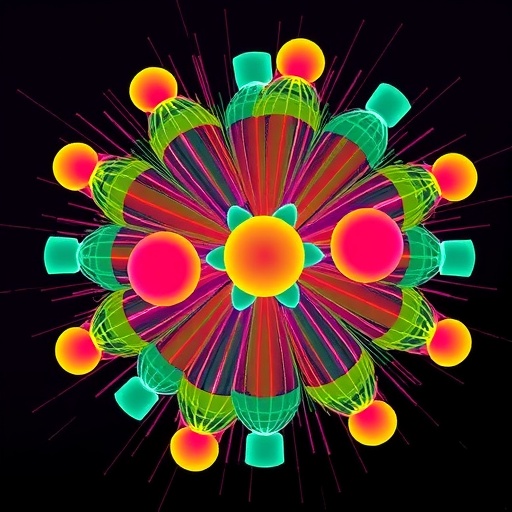In an exciting development that pushes the frontiers of particle physics, scientists have proposed a novel experimental approach to unravel the enigmatic nature of exotic hadrons, specifically those with hidden charm and strangeness. These elusive states, often heralded as tetraquark candidates, challenge the well-established quark model and demand innovative techniques for characterization. The latest research focuses on the near-threshold states of the bound systems involving charm and strange quarks, notably the ( D^0 D_s^{*-} ) system, and offers femtoscopy as a powerful tool to expose their underlying structures.
The strong interaction, governed by Quantum Chromodynamics (QCD), dictates the behavior of quarks and gluons, the fundamental constituents of matter. While QCD is elegant in theory, its non-perturbative nature at low energies obstructs straightforward computations and necessitates indirect experimental observations. Traditionally, hadrons—color-neutral composite particles—have been classified into mesons and baryons based on their quark content. However, discoveries since the early 2000s of exotic hadrons defy this classification, hinting at more complex quark arrangements, including tetraquark and pentaquark configurations.
Among the groundbreaking findings in this domain are the hidden-charm tetraquark candidates ( Zc(3900)^{\pm} ) and ( Z{cs}(3985)^{-} ). The former, discovered through the invariant mass analysis of the ( J/\psi \pi^\pm ) channel in electron-positron collision experiments, sparked debates about its true nature—whether it is a tightly bound tetraquark or a loosely coupled meson molecule. The latter, announced more recently, brings an additional layer of strangeness to the table, potentially representing a strangeness counterpart of the ( Z_c(3900) ). Its quark composition, ( ccsu ), contrasts with the ( Z_c(3900) )’s ( ccdu ), entering uncharted territory in the understanding of strong interaction dynamics with open strangeness.
A particularly knotty question that has vexed physicists concerns the internal configuration of these tetraquark candidates. The theoretical models variously depict them as resonant states—unstable particles with a finite lifetime, virtual states—dynamic fluctuations without a well-defined energy peak, or bound states with a mass slightly below their constituent thresholds. Discriminating among these scenarios is notoriously difficult because conventional methods, especially the analysis of invariant mass spectra, often fail due to phase-space suppression near thresholds, masking characteristic signatures.
Addressing this challenge, the newly proposed methodology leverages femtoscopic correlation functions, a technique traditionally employed to probe the spatial and temporal structure of particle-emitting sources in heavy-ion collisions. By measuring the momentum correlations of ( D^0 D_s^{*-} ) pairs produced in high-energy proton-proton collisions at facilities like the Large Hadron Collider (LHC), researchers can capture their interaction details with unprecedented precision. The minute relative momenta of these meson pairs encode information about their final-state interactions and thus on the possible formation scenarios of exotic states.
The theoretical framework supporting this approach integrates effective field theory with the Koonin-Pratt formalism, a cornerstone in femtoscopy. This combination allows for a systematic calculation of correlation functions, mapping out how they change across different momentum regimes. Importantly, the results indicate pronounced differences in the behavior of the correlation functions depending on whether the system corresponds to a resonant, virtual, or bound state. These distinctions are most prominent at low momenta, where the meson pairs are closest to the energy threshold governing their interactions.
In the low-momentum domain, the calculated correlation functions diverge markedly. Resonant states produce characteristic peaks distinct from the subtle enhancements associated with virtual or bound states. The sensitivity of femtoscopy in this range thus offers an invaluable diagnostic power to discern the nature of the underlying meson interactions. This capability represents a significant advancement over classical invariant mass methods, which are plagued by kinematic suppression effects and often result in ambiguous interpretations.
At higher relative momenta, the differences persist but manifest in more intricate structures within the correlation functions. These features are intimately connected to the scattering phase shift, an essential quantity characterizing the meson-meson interaction potential. In the resonant scenario, the phase shift undergoes rapid variation, generating sharp modulations of the correlation signal observable experimentally. Such precise fingerprints can serve as robust markers, enabling experimentalists to confirm or refute competing theoretical models.
The adoption of proton-proton collision experiments for these studies is strategic. Unlike heavy-ion collisions, proton-proton systems provide cleaner environments with fewer background processes, ensuring that femtoscopic measurements retain high fidelity. Recent advances in detector technology and data analysis algorithms at the LHC are poised to facilitate the exquisite momentum resolution and particle identification required for this endeavor.
This innovative research paradigm underscores the importance of integrating multiple complementary observables—momentum correlation functions alongside invariant mass spectra—to holistically tackle the exotic hadron puzzle. The synergy between these two perspectives promises to overcome the limitations inherent in each individually, yielding a more comprehensive understanding of tetraquark configurations, decay dynamics, and their formation mechanisms.
Furthermore, the implications of this approach extend beyond exotic charmed-strange states. The methodology can be adapted to study a broader class of near-threshold hadronic systems containing different flavors or quantum numbers. By refining our grasp of hadron formation and the interplay of quark constituents, such investigations can illuminate profound questions regarding the non-perturbative regime of QCD and the emergence of complex matter in the universe.
In conclusion, the proposal to employ femtoscopic momentum correlations as a discriminator between resonant, virtual, and bound state interpretations of tetraquark candidates heralds a new epoch in particle physics experimentation. By bridging theory and high-precision measurement, this strategy complements ongoing experimental campaigns and enhances our capacity to decipher the quark-gluon substructure that shapes the visible cosmos. Upcoming data analyses at the LHC and other collider facilities will critically test these predictions, potentially crystallizing our understanding of exotic hadrons and the fundamental bonds that govern them.
Subject of Research: Exotic hadrons and their near-threshold states involving charm and strangeness, with a focus on the ( D^0 D_s^{*-} ) system and tetraquark candidates.
Article Title: Not explicitly provided.
News Publication Date: Not explicitly provided.
Web References: http://dx.doi.org/10.1016/j.scib.2025.09.022
References: Not specified beyond the DOI link.
Image Credits: ©Science China Press
Keywords
Quantum Chromodynamics, Exotic Hadrons, Tetraquarks, Femtoscopy, Momentum Correlation Functions, Resonant States, Virtual States, Bound States, Charm-Strange Systems, LHC, Particle Physics, Hadron Molecules




